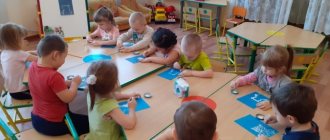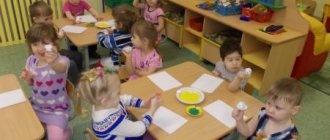Summary of a lesson on speech development of children of primary preschool age “A story about your family”
Municipal preschool educational budgetary institution
"Kindergarten care and health care No. 110"
on children's speech development
junior preschool age
"A story about your family."
Target:
To develop in children the ability to answer adult questions; activate adjectives, verbs; consolidate the pronunciation of the sounds “g” “p”. Find out the composition of your family. Teach to treat your family members with respect. Learn to listen to the poetic form of riddles. To develop the ability to control the sensations of one’s own body, to reproduce a given pose as shown.
Material.
Painting "Hen and Chicks".
- Guys, I can see from your eyes and smiles that you are in a good mood. Do you want me to guess why? I guessed that you were in a good mood because you came to kindergarten and your friends met you here. Did you guess right? And you also know that we will study with you and you will definitely learn something new! (Children's answers).
— Guys, look at this picture (the painting “Hen and Chicks”)
- Children, who is this? (chicken)
- Guys, who is the chicken for the chickens (mother)
- Is there a cockerel for chickens? (dad)
- And chickens for dad are a rooster and for mom - hens, who? (Children).
Plan for the practical lesson “My Family” in the group
The second part of the GCD is the actual lesson plan for children. Since a teacher is a creative profession, we can call the plan a script. If you write everything down in detail and to the letter, then it will be much easier to carry out later. Children's reactions to questions and games cannot always be predicted. But you can suggest if you see a misunderstanding, and take this into account next time.
At the beginning of the lesson you need to say hello, in the plan we write: “Greetings.” We write down the words that we will use to greet each other and that we will offer to say to the children. Since this is a certification class, it is highly advisable to say hello to the commission. Next come games and activities.
"Stories about my family." Summary of educational activities using ICT on the topic “Moms” in the second junior group
Svetlana Navodchikova
“Stories about my family.” Summary of educational activities using ICT on the topic “Moms” in the second junior group
Summary of continuous educational activities
using ICT
on the topic " Moms "
in
the second junior group “Baby”
Topic of the day: “ Stories about your family ”
Author : teacher Navodchikova Svetlana Anatolyevna SP GBOU secondary school village. Priboy-kindergarten “Zorenka”
.
-develop children’s ability to answer the teacher’s questions;
-activate adjectives, verbs;
- consolidate the pronunciation of sounds [g], [p] ( “Speech development”
);
— clarify the composition of your family ;
— to develop in children the ability to listen attentively to the poetic form of riddles ( “Artistic and aesthetic development”
);
— develop fine motor skills of the hands ( “Physical development”
).
1. Verbal: artistic expression, children's stories .
2. Visual: looking at cards , viewing a presentation.
3.Practical: surprise moment, game.
1. Examination of illustrations “ For the Family ”
.
2. Learning nursery rhymes about family .
3. Reading poems about family .
4. Looking at photos of mothers and fathers of children.
.Materials and equipment:
— demonstration material: presentation “Hen and Chicks”
;
— visual material: cap, steering wheel, laptop.
activities Forms and methods of organizing joint activities
Motor Game exercises, physical education, outdoor games
Game Game situations, games with rules
Communicative Conversations, questions
Perception Reading a poem.
Logic of educational activities:
No. Activities of the teacher Activities of the pupils Expected result
Who's screaming in the yard?
Invites you to go to the “Bird Yard”
. They solve riddles.
They stand behind the teacher. They follow the teacher. Created interest in upcoming activities.
Shows 1 slide.
-What is shown in the picture?
-Who is the chicken for the chickens?
- What does a rooster mean to chickens?
- Who are the chickens for mom and dad ?
- That's right, but who are the cockerel and the hen for the chickens? And all together they are family . Look at the slide .
Answer questions. They know how to answer the teacher’s questions.
Shows slide 2.
-How does a mother hen talk to her babies?
Shows slide 3.
Leave your comment
MSUPE specialists have launched a project to modernize the methodological training of teachers
Reading time: 3 minutes
Rosobrnadzor: almost half of teachers do not reach the basic level of training
Reading time: 2 minutes
The strategic academic leadership program for the country's universities was presented at SPIEF 2021
Reading time: 2 minutes
Applicants will be able to enter a university based on their success outside of school
Reading time: 2 minutes
The Unified State Examination takes place regularly throughout Russia.
Reading time: 1 minute
An Italian teacher gave children a summer assignment and became famous
Reading time: 4 minutes
Gift certificates
Responsibility for resolving any controversial issues regarding the materials themselves and their contents is taken by the users who posted the material on the site. However, the site administration is ready to provide all possible support in resolving any issues related to the work and content of the site. If you notice that materials are being used illegally on this site, please notify the site administration using the feedback form.
All materials posted on the site were created by the authors of the site or posted by users of the site and are presented on the site for informational purposes only. Copyrights for materials belong to their legal authors. Partial or complete copying of site materials without written permission from the site administration is prohibited! The opinion of the administration may not coincide with the point of view of the authors.
Source
Preparatory (theoretical) part of the GCD
Let's look at the objectives of this lesson. They can be direct - to figure out who is who in the family, what they do. But next to the straight lines there will also be auxiliary ones. There are no standard tasks; they are prescribed specifically for the lesson. Exercises will then be selected for them. It is logical that program tasks and group activities during NOD correspond to each other.
So, tasks (goals) can be:
- Consolidate and systematize knowledge about family members and how they take care of each other, as well as their home.
- Foster positive emotions, love and respect for your family, pride in family members and your home.
- Enrich your vocabulary. For example, fix the names of family members, the names of fingers (if finger games are expected). And also activate words such as “mommy, daddy, kind, beloved, loves,” etc.
- Continue to develop fine motor skills (the same finger games, applique).
- Develop auditory attention, thinking and storytelling skills.
- Get joy from the work done and completed (for example, an application).
FGT requires that educational areas be integrated into the lesson and a game component be used. Therefore, after or before the “Goals” point, we make the “Integration of educational areas” point. It could be:
- cognition (when a holistic picture of the world is formed);
- communication;
- creativity (if the children draw, make appliqué, etc.);
- health (if there is physical education).
Among the types of activities may be gaming, communicative, creative, reading. It all depends on what practical tasks you include in the GCD.
Organizational aspects of certification
I will briefly discuss what certification is and why it is required. The event affects almost all teachers who want to confirm their professional category or obtain a higher one. Scheduled certification is carried out every 5 years. During the so-called certification period, two open classes must be held.
They will be attended by experts - members of the certification commission. The task of the latter is to evaluate the experience, professional level and competence of the teacher. There are areas of assessment, for each of which a score is assigned. Here they are:
- general organization of the lesson;
- didactic activity of the person being certified;
- his educational activities;
- “portrait” of a teacher (a set of professional and personal traits);
- characteristics of the group.
Each direction is assessed according to certain criteria. Therefore, it is important to approach the lesson comprehensively. That is, take into account safety precautions and sanitary standards, calculate the time of the lesson, and take into account the age of the children. And also make sure everything is clear, follow goals, and increase children’s motivation. And, preferably, make sure that the kids like it.
The duration of the educational activity, in particular the “My Family” lesson, is determined by the age of the children. For the 2nd junior group it is 13-15 minutes, maximum 17 minutes. With children aged 3-4 years, the teacher talks through the actions and then shows them by example. Directions should be precise, short, unambiguous and interesting for children. If the task is complex, it must be divided into several stages.
The lesson notes for certification in the 2nd junior group “My Family” can be compiled in the form of a table, which will contain the following lines:
- Information about the teacher/developer (full name, position, place of work).
- Title (in this case “My Family”).
- Integration of educational areas.
- Activities.
- Program tasks, goals.
- Materials and equipment. Everything must be clearly stated: pictures, cards, books, laptop, music recordings, toys, etc.
- Introductory part (say hello, state the problem).
- The main part (directly gaming and educational activities).
- Final part (praise for good work, cleaning up toys).
Points 1-4 can be called the preparatory part. And 5-7 is direct practice. That is, the “My Family” lesson itself, which will unfold in a group.




